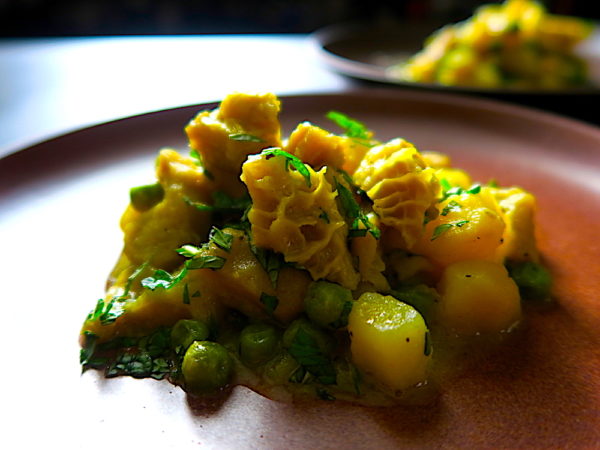Cau Cau is one of many creole dishes popular in Afro-Peruvian kitchens, and is thought to have originated in Lima by cooks that out of necessity prepared offal recipes with tripe or beef heart. Today, Cau Cau is also prepared with chicken or fish, but here I present the traditional recipe with beef honeycomb tripe that my mom taught me how to cook.
One of my favorite places in Lima to enjoy Cau Cau is Antigua Taberna Queirolo in Pueblo Libre, and for lunch we usually order Papa Rellena and Cau Cau with Chilcano Pisco cocktails. Here in San Francisco, I have not seen Cau Cau at local Peruvian restaurants, but I’ve seen tripe dishes at some Dim Sum restaurants. Since beef tripe is not readily available at my local market, it took some searching to find a place that sold cleaned beef honeycomb tripe, or mondongo.
I am very proud to be serving this dish at my upcoming Afro-Peruvian Creole Feast at 18 Reasons, where we’ll be celebrating the culinary culture of Black Peru during Black History Month in San Francisco. Here’s what you need in order to savor the traditional flavors of Cau Cau in your own home.
INGREDIENTS FOR POACHING TRIPE
- 1 lb. beef honeycomb tripe, cleaned
- 1-2 quarts water
- 2 sprigs fresh mint
INGREDIENTS FOR SOFRITO
- 2 tablespoons cooking oil
- 1 cup red onion, diced
- 2 teaspoon garlic paste
- 1/2 teaspoon aji amarillo paste
- 1/4 teaspoon salt
- 1/4 teaspoon pepper
- 1/4 teaspoon cumin
- 1/4 teaspoon oregano
- 1/4 teaspoon turmeric
INGREDIENTS FOR STEW
- 1 lb. poached tripe, cut into 1″ pieces
- 1 lb. yellow potatoes, peeled and cut into 1″ cubes
- 1 cup green peas
- 2 cups tripe stock
- 2 teaspoons chicken bouillon paste
- chopped mint for garnish
In addition to the ingredients above, you’ll need one pot for poaching the tripe, and another for cooking the stew.
PREPARATION FOR POACHING TRIPE
- Place tripe into pot with enough water to cover
- Bring to a boil, and simmer for 30 minutes
- Remove from heat and discard water
- Add water again to cover the tripe, and add sprigs of mint
- Bring to a boil again, and simmer for 30 more minutes
- Remove tripe and set aside to cool, once cooled the tripe should be tender enough to tear by hand
- Save tripe stock, and strain mint
PREPARATION FOR SOFRITO
- Heat cooking oil in a large pot over medium to high heat
- Add the garlic paste and diced onions
- Season with salt, pepper, cumin, oregano, and turmeric
- Add aji amarillo and sauté for a few minutes until onions are translucent
PREPARATION FOR STEW
- Cut the poached tripe into 1″ pieces
- Add the tripe pieces to the pot with the onion sofrito and mix well
- Add 1 cup of tripe stock, bring to a boil and simmer for 10 minutes
- Add the cubed potatoes, 1 more cup of tripe stock
- Mix well, taste stock and add chicken bouillon or adjust salt if needed
- Bring to a boil, and simmer for 20 more minutes, or until potatoes are cooked and the stock thickens
- Add the green peas, and continue to simmer for 5 more minutes
- Serve and garnish with chopped mint
SERVINGS
4 servings.
NOTES
After much consulting with my meat monger friends, I was able to source some cleaned and blanched beef honeycomb tripe from Golden Gate Meat Co. in the Ferry Building. My order was packed in individual 1 lb. sealed bags, perfect for freezing and portioning.
To make garlic paste, purée peeled garlic cloves with enough olive oil to create a smooth paste. Refrigerate the garlic paste in an airtight jar and use in a recipe as you would minced garlic.
Aji amarillo is a very traditional Peruvian hot pepper with a savory flavor, yellow color, and lingering heat that is very important in this dish. In this recipe, I use it in paste form. In San Francisco, you can pick up many Peruvian ingredients at Latino Markets such as Evergreen Market in The Mission District where the aji amarillo paste is sold in small jars.
The challenge in cooking this dish is in finding the right balance of flavor between the tripe and all the other ingredients. If the tripe flavor is too strong, it may overwhelm the other savory components, that’s why the water is changed during poaching. Conversely, if the tripe stock is mild after poaching, you can make it more savory by adding chicken bouillon when preparing the stew. In this recipe I used Better Than Bouillon Chicken Base.
